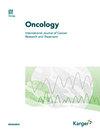骨骼肌质量和营养状况对接受 nivolumab 治疗的复发性或晚期胃癌患者的临床影响。
IF 2.5
3区 医学
Q3 ONCOLOGY
引用次数: 0
摘要
背景 本研究旨在评估接受 nivolumab 单药晚期治疗的胃癌患者骨骼肌质量和营养状况的临床影响。方法 我们对 90 名曾接受过抗 PD-1 疗法(nivolumab)的胃癌患者进行了一项多机构回顾性研究。在尼夫单抗诱导前拍摄的计算机断层扫描图像上,骨骼肌指数(SMI,cm2/m2)被定义为竖立肌面积(cm2)除以身高(m)的平方。患者分为两组:SMI 高(n = 45)和 SMI 低(n = 45)。在尼夫单抗诱导前还计算了预后营养指数(PNI)。分析了SMI和PNI与应答率(RR)、无进展生存期(PFS)、总生存期(OS)、疾病控制率(DCR)和安全性的关系。结果 SMI 的临界值男性为 13.45,女性为 10.41。SMI高与较高的RR(几率比=12.36,P=0.02)和DCR(几率比=2.97,P=0.02)明显相关。尽管不显著,但 PNI 高也往往与较高的 RR 相关。多变量分析表明,SMI高与胃癌的较高RR和较高DCR独立相关。此外,预后分析表明,SMI高(对数秩检验 p = 0.008)和PNI高(对数秩检验 p = 0.0008)与nivolumab诱导后更长的OS显著相关。SMI高也与更长的PFS相关(对数秩检验 p = 0.03)。SMI-低和SMI-高之间的irAE无明显差异。结论 SMI 和 PNI 与尼夫单抗在胃癌患者中的疗效相关。对即将接受尼伐单抗治疗的胃癌患者进行骨骼肌损失和营养状况管理将有利于提高生存率。本文章由计算机程序翻译,如有差异,请以英文原文为准。
Clinical impact of skeletal muscle mass and nutritional status in patients with recurrent or advanced gastric cancer treated with nivolumab.
Background This study aimed to evaluate the clinical impact of skeletal muscle mass and nutritional status in gastric cancer patients treated with nivolumab monotherapy as late-line treatment. Methods We conducted a multi-institutional retrospective study of 90 gastric cancer patients who previously received anti-PD-1 therapy (nivolumab). On computed tomography images captured before nivolumab induction, the skeletal muscle index (SMI, cm2/m2) was defined as the erector muscle area (cm2) divided by the height (m) squared. Patients were divided into two groups: those with SMI-high (n = 45) and those with SMI-low (n = 45). Prognostic nutritional index (PNI) was also calculated before nivolumab induction. The associations of SMI and PNI with response rate (RR), progression-free survival (PFS), overall survival (OS), disease control rate (DCR), and safety were analyzed. Results The cutoff values for SMI were determined as 13.45 for males and 10.41 for females. SMI-high was significantly associated with a higher RR (odds ratio = 12.36, p = 0.02) and DCR (odds ratio = 2.97, p = 0.02). Although not significant, PNI-high also tended to be associated with a higher RR. Multivariate analysis showed that SMI-high was independently associated with a higher RR and higher DCR in gastric cancer. Moreover, prognostic analyses revealed that SMI-high (log-rank test p = 0.008) and PNI-high (log-rank test p = 0.0008) were significantly associated with longer OS since nivolumab induction. SMI-high was also associated with longer PFS (log-rank test p = 0.03). There were no significant differences in irAE between SMI-low and SMI-high. Conclusions SMI and PNI were associated with nivolumab efficacy in gastric cancer patients. Management of skeletal muscle loss and nutritional status in gastric cancer patients who will receive nivolumab would be beneficial to enhance survival outcomes.
求助全文
通过发布文献求助,成功后即可免费获取论文全文。
去求助
来源期刊

Oncology
医学-肿瘤学
CiteScore
6.00
自引率
2.90%
发文量
76
审稿时长
6-12 weeks
期刊介绍:
Although laboratory and clinical cancer research need to be closely linked, observations at the basic level often remain removed from medical applications. This journal works to accelerate the translation of experimental results into the clinic, and back again into the laboratory for further investigation. The fundamental purpose of this effort is to advance clinically-relevant knowledge of cancer, and improve the outcome of prevention, diagnosis and treatment of malignant disease. The journal publishes significant clinical studies from cancer programs around the world, along with important translational laboratory findings, mini-reviews (invited and submitted) and in-depth discussions of evolving and controversial topics in the oncology arena. A unique feature of the journal is a new section which focuses on rapid peer-review and subsequent publication of short reports of phase 1 and phase 2 clinical cancer trials, with a goal of insuring that high-quality clinical cancer research quickly enters the public domain, regardless of the trial’s ultimate conclusions regarding efficacy or toxicity.
 求助内容:
求助内容: 应助结果提醒方式:
应助结果提醒方式:


